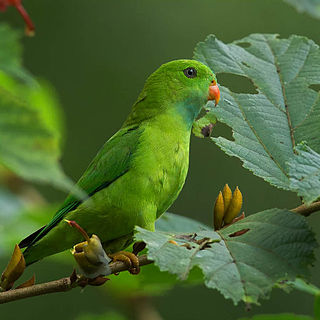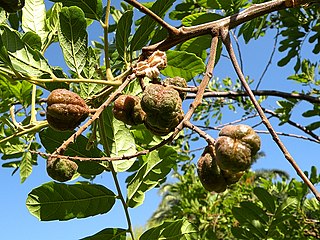
The vernal hanging parrot is a small parrot which is a resident breeder in the Indian subcontinent and some other areas of Southeast Asia. It undergoes local movements, driven mainly by the availability of the fruit, seeds, buds and blossoms that make up its diet. They frequent the banyan tree for the fruit and plantain trees for the nectar from the flowers.

Frovatriptan, sold under the brand name Frova, is a triptan drug developed by Vernalis for the treatment of migraine headaches and for short term prevention of menstrual migraine. The product is licensed to Endo Pharmaceuticals in North America and Menarini in Europe.

The smooth green snake is a species of North American nonvenomous snake in the family Colubridae. The species is also referred to as the grass snake. It is a slender, "small medium" snake that measures 36–51 cm (14–20 in) as an adult. It gets its common name from its smooth dorsal scales, as opposed to the rough green snake, which has keeled dorsal scales. The smooth green snake is found in marshes, meadows, open woods, and along stream edges, and is native to regions of Canada, the United States, and northern Mexico. A non-aggressive snake, it seldom bites and usually flees when threatened. It mates in late spring to summer, and females lay their eggs from June to September. The smooth green snake will often bob its head in order to mimic vegetation blowing in the wind.

Adonis vernalis, known variously as pheasant's eye, spring pheasant's eye, yellow pheasant's eye and false hellebore, is a perennial flowering plant in the buttercup family Ranunculaceae. It is found in dry meadows and steppes in Eurasia. More specifically, this plant grows in a wide range of locations which include open forests, forest clearings, dry meadows, mesic steppe, and mostly calcareous soil. Isolated populations are found from Spain in the west across Central Europe with fine examples in Valais, Switzerland, and southern Europe, reaching southern Sweden in the north and Abruzzo in the south, with its main area of distribution being the Pannonian Basin and the West Siberian Plain. In contrast to most other European Adonis species, the flowers appear in springtime, and are up to 80 mm (3.1 in) in diameter, with up to 20 bright yellow petals. Not only do the flowers begin to grow, but so do the plants aerial organs, from around April to May.

Opheodrys is a genus of small to medium-sized nonvenomous colubrid snakes commonly referred to as green snakes. In North America the genus consists of two distinct species. As their common names imply, the rough green snake has keeled dorsal scales, whereas the smooth green snake has smooth dorsal scales.

Pulsatilla vernalis is a species of flowering plant in the family Ranunculaceae, native to mountainous habitats in Europe. Growing to 10 cm (4 in) high and wide, it is a semi-evergreen perennial with hairy, divided leaves. In early spring it bears anemone-like flowers which are up to 6 cm (2 in) in diameter, white flushed with violet on the outer surface of the petals, and prominent yellow stamens.

Liocarcinus vernalis, the grey swimming crab, is a small, shallow-water crab in the family Portunidae. L. vernalis was thought for a long time to be a predominantly Mediterranean species, but its known range was extended by a series of observations in the 1980s and 1990s. It ranges from West Africa to the southern North Sea.

Ormeau is a hinterland town and suburb in the City of Gold Coast, Queensland, Australia. In the 2016 census, the suburb of Ormeau had a population of 14,460 people.

Hamamelis vernalis, the Ozark witchhazel is a species of flowering plant in the witch-hazel family Hamamelidaceae, native to the Ozark Plateau in central North America, in Missouri, Oklahoma, and Arkansas. It is a large deciduous shrub growing to 4 m (13 ft) tall.

Senecio vernalis is one of the European species of Senecio, an annual that is also known as eastern groundsel. While it has been long classified as Senecio vernalis, this species has more recently been described as a subspecies of Senecio leucanthemifolius and is now included by some in that species.
Ophisma tropicalis is a moth of the family Noctuidae first described by Achille Guenée in 1852. It is found in tropical and subtropical America, from the south of the United States to Uruguay, including Brazil, Guadeloupe, Martinique, Saint Kitts, Montserrat, Saint Vincent, Grenada, the Greater Antilles, Cuba, the Dominican Republic, Jamaica and Colombia.

Indantadol is a drug which was formerly being investigated as an anticonvulsant and neuroprotective and is now under development for the treatment of neuropathic pain and chronic cough in Europe by Vernalis and Chiesi. It acts as a competitive, reversible, and non-selective monoamine oxidase inhibitor, and as a low affinity, non-competitive NMDA receptor antagonist. A pilot study of indantadol for chronic cough was initiated in October 2009 and in April 2010 it failed to achieve significant efficacy in neuropathic pain in phase IIb clinical trials.

Cupania is a genus of flowering plants in the family Sapindaceae. It includes 58 species native to the tropical Americas, ranging from Mexico and south Florida through Central America, the Caribbean, and South America to northern Argentina.

Vernalis is an unincorporated community in San Joaquin County, California, United States. Vernalis is located on California State Route 33 10.5 miles (16.9 km) southeast of Tracy. It was named after two daughters of local ranchers: Verna Carpenter and Alice Hamilton. Vernalis has a post office with ZIP code 95385. The first post office in the area opened in San Joaquin City in 1851; that post office closed in 1852, reopened in 1874, and was moved 3 miles (4.8 km) southwest in 1888, after which its name was changed to Vernalis.

Naval Auxiliary Air Station Vernalis was a United States Navy facility located in the small town of Vernalis, California during World War II. It opened on June 8, 1943, and closed on October 15, 1945.

Toechima daemelianum, commonly known as cape tamarind, is an evergreen tree from north-east Queensland in Australia. It grows up to 13 metres high and a trunk which may be up to 20 cm wide.

Trypocopris vernalis, known sometimes by the common name spring dumbledor or spring dor beetle, is a type of dung beetle. The larva of Trypocopris vernalis feeds on dung of animals such as sheep and red foxes.
Cupania elegans is a horticultural name for a plant in the family Sapindaceae.
Vernalis plc was a UK-based pharmaceuticals business headquartered in Winnersh, with research in Cambridge, and with a Berwyn, PA, US-based commercial operation, Vernalis Therapeutics Inc., focusing on the sales and marketing of slow-release formulations of prescription cough and cold medicines. Tuzistra XR was the first launched product which arose from this strategy, however sales did not reach expectations. As a result, the strategy was abandoned and the company was put up for sale. Vernalis plc was listed on AIM until its acquisition by Ligand Holdings (UK) Ltd, a subsidiary of Ligand Pharmaceuticals, Inc. (NASDAQ:LGND) on 10 October 2018.
Cupania cinerea is a plant species in the family Sapindaceae. It was described as a new species in 1843 by German botanist Eduard Friedrich Poeppig. The plant is native to South America and Central America.

















